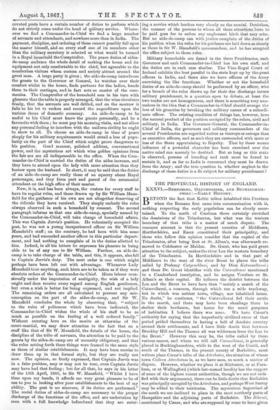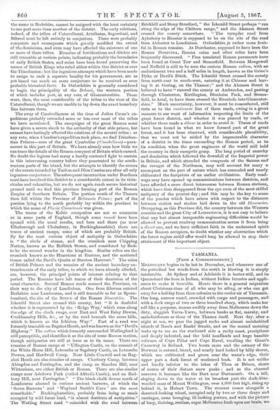THE PROVINCIAL HISTORY OF ENGLAND.
XXXVI.—BERKSHIRE, OXFORDSHIRE, AND BUCKINGHAM- SHIRE :-EARLY HISTORY. BEYOND the fact that Keltic tribes inhabited this Province when the Romans first came into communication with it, nothing respecting the early population can be clearly ascer- tained. To the north of Cautium there certainly- stretched the dominions of the Trinobantes, but what was the western boundary of that tribe is a matter of much dispute. The common account is that the present counties of Middlesex, H.ertfordshire, and Essex constituted their principality, and those who follow this opinion consider that the capital of the Trinobantes, after being first at St. Alban's, was afterwards re- moved to Colchester or Mahlon. Dr. Guest, who has paid great attention to the subject, makes the river Lea the western boundary of the Trinobantes. In Hertfordshire and in that part of Middlesex to the west of the river Brent he places the tribe called by Ptolemy Catyeuehlani, and by Dion Kataouellanoi ; and these Dr. Guest identifies with the Caduvellauni mentioned in a Cumberland inscription, and he assigns Verulam Or St. Alban's as their capital. He believes the district between the Lea and the Brent to have been then "mainly a march of the Catuvellauni, a common, through which ran a wide trackway, but in which was neither town, village, nor inhabited house. No doubt," he continues, "the Catavellauni fed their cattle in the march, and there may have been shealings there to shelter their herdsmen, but house for the usual purposes of habitation I believe there was none. We have Caasar's authority for saying that the imperfectly civilized races of that period prided themselves in having a belt of desolate country around their settlements, and I have little doubt that between Brockley Hill and the Thames all was wilderness from the Lea to the Brent." However this may be, the tribe called by these various names, and whom we will call Catuvellauni, is generally placed in Buckinghamshire, while to the west of the Cantii, and south of the Thames, in the present county of Berkshire, most writers place Caasar's tribe of the Attrebates, the situation of whose town Calleva Attrebatum is, as we have seen, so much a matter of dispute. However, whether we place it at Silchester, or at Farn- ham, or at Wallingford (which last-named locality has the support of some of the highest recent authorities, though we are not satis fled with their arguments), there can be little doubt that Berkshire was principally occupied by theAttrebates, and perhaps West Surrey may be added to their territories. The mysterious Segontiaci of the south we are inclined to place in the most northerly parts of Hampshire and the adjoining parts of Berkshire. The Bibroci, mentioned by Czesar, and who are supposed by some to have given
the name to Berkshire, cannot be assigned with the least certainty to one part more than another of the district. The early relations, indeed, of the tribes of Catuvellauni, Attribates, Segontiaci, and Bibroci must be left entirely to conjecture. There were probably conquests and reconquests which greatly modified the extent of the dominions, and even may have affected the existence of one or more of these tribes. Remains of fortifications and ditches are still traceable at various points, indicating probably the boundaries of early British States, and coins have been found preserving the names of British Kings who ruled either within this district or over the Trinobantes ; but the ingenious attempts which have been made to assign to each a separate locality for his government, are as yet based too much on mere conjecture to be received as even probable historical facts. In Oxfordshire is generally considered to begin the principality of the Dobuni, the western portion of which includes part, at any rate, of Gloucestershire. These were, then, the moat considerable of the tribes to the west of the Cattivellauni, though we are unable to lay down the exact boundary line between them.
The sway of Cassivellaunus at the time of Julius eraser's ex- peditions probably extended more or less over most of the tribes we have mentioned. The campaigns of the great Roman must have given a severe shock to the authority of that able prince, but cannot have lastingly affected the relations of the several tribes ; at any rate, when Claudius's expedition took place, we find Trinoban- tian Princes—sons of the great Cymbeline (Cunobelinus)—para- mount in this part of Britain. We have already seen how little we can traCe the details of the Roman conquest of Britain which ensued. No doubt the legions had many a hardly contested fight to sustain in this intervening country before they penetrated to the south- western parts of the island, but the attempts to identify the scenes of the events recorded by Tacitus and Dion Cassius are after all only ingenious conjectures. The subsequent insurrection under Boadicea must have involved this district to a considerable extent in its vicis- situdes and calamities, but we do not again reach secure historical ground until we find this province forming part of the Roman Empire of Southern Britain. The portion south of the Thames then fell within the Province of Britannia Prima ; part of the portion lying to the north probably lay within the province to which the name of Flavia Ciesariensis was given.
The traces of the Keltic occupation are not so numerous as in some parts of England, though some tumuli have been opened with the usual results, and here and there (as near Ellesborough and Cholesbury, in Buckinghamshire) there are traces of ancient camps, some of which are probably British. By far the most curious object of antiquity in Oxfordshire is "the circle of stones, and the cromlech near Chipping Norton, known as the Rollrich Stones, and considered by Bede to be the second wonder in the kingdom. Similar relics are the cromlech known as the Hoarstone at Enstone, and the scattered stones called the Devil's Quoits at Stanton Harcourt." The coins of British Princes and the remains of the ancient boundary en- trenchments of the early tribes, to which we have already alluded, are, however, the principal points of interest relating to that period. The Romans have left traces of their dominion of the usual character. Several Roman roads crossed the Province, on their way to the city of Londinium. One from Glevum entered Berkshire near Lambourne, and is still traceable as far as Speen- hamland, the site of the SPINX of the Roman Itineraties. The Ickenild Street also crossed this county, but "it is doubtful whether it is represented by the 'Ridge Way,' which runs along the edge of the chalk range, over East and West Raley Downs, Cuckhamsley Hills, &c., or by the road beneath the same hills, which is known as the Ickleton Way." Part of a road was formerly traceable on Bagshot Heath, and was known as the "Devil's Highway." The vallutn which formerly surrounded Wallingford is still perceptible, and identifies it as the site of some Roman station, though antiquaries are still at issue as to its name. There are remains of Roman camps at " Uffington Castle, on the summit of the White Horse Hill, Letcombe or Sagsbury Castle, on Lacombe Downs, and Hardwell Camp. Near Little Coxwell and on Bag- shot Heath are also remains of camps. Cherbury Camp, between Abingdon and Farringdon, and the camp on Sinodun Hill, near Wittenham, are either British or Roman. There are also similar camps near Ashdown Park (called Alfred's Castle), and on Bad- bury Hill, near Farringdon." "The black chalk downs north of Lambourne abound in curious ancient barrows, of which the 'Seven Barrows' and Wayland Smith's Cave' are the most remarkable." Buckinghamshire, probably from being so much occupied by wild forest laud, "is almost destituteOf antiquities." The Watling Street -road "coincided with the road between Brickhill and Stony Stratford," the Ickenild Street perhaps "ran along the edge of the Chiltern range," and the Akenam Street crossed the county somewhere. "The turnpike road from Aylesbury to Bicester is supposed to be on the site of the road from Alchester to Londinium. Oxfordshire _is rather more fruit- ful in Roman remains. At Dorchester, supposed to have been the Roman DORICINA, Roman coins and other relics have been frequently discovered. "Fine tesselated Roman pavements have been found at Great Tew and Stonesfield. Between Mongewell and Nuffield is still to be seen the curious Roman vallum, with an embankment two and a half miles in length, known as the Grine's Dyke or Devil's Ditch. The Ickenild Street crossed the county from north-east to south-west, entering it at Chinnor and leav- ing it at Goring, on the Thames ;" and the Akenam Street is believed to have "entered the county at Ambrosden, and passing through Chesterton, Kirtlington, Blenheim Park, and Stones-. field, to Astal, to have there crossed the Evenlode into Gloucester- shire." Much uncertainty, however, it must be remembered, still rests as to the continuous line of these roads, owing in a great measure to our want of information respecting the limits of the great forest district, and whether it was pierced by roads, or whether these made a detour in order to avoid it. Traces of roads have been found in what we know formed part of the great forest, and it has been observed, with considerable plausibility, that we must not be misled by the impenetrable character of a district in the times succeeding the Roman period, as fa- its condition when the great engineers of the world still held' the country in their energetic grasp. The long period of anarchy and desolation which followed the downfall of the Imperial power- in Britain, and which attended the conquests of the Saxons and the ravages of the Northmen, may well account for many a reconquest on the part of nature which has concealed and nearly obliterated the footprints of an earlier civilization. Early road- ways may have opened up communications between districts, an& have afforded a more direct intercourse between Roman stations, which have thus disappeared from the eye even of the most skilful antiquary of the present day ; and this may be the key to some- of the puzzles which have arisen with respect to the distances- between station and station laid down in the old Itineraries Occupying, as this Province did, the country between the Western counties and the great City of LONDINIUM, it is not easy to believe. that any but almost insuperable engineering difficulties would be- allowed to prevent roadway communication across it from being- a direct one, and we have sufficient faith in the undaunted spirit: of the Roman occupiers, to doubt whether any obstruction which the forest region could offer would long be allowed to stop their- attainment of this important object.































 Previous page
Previous page